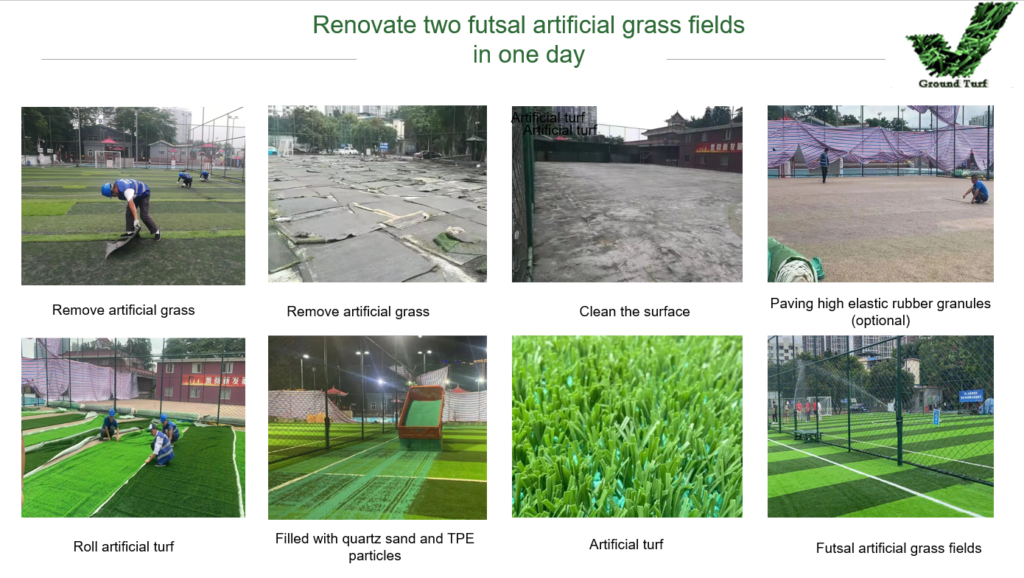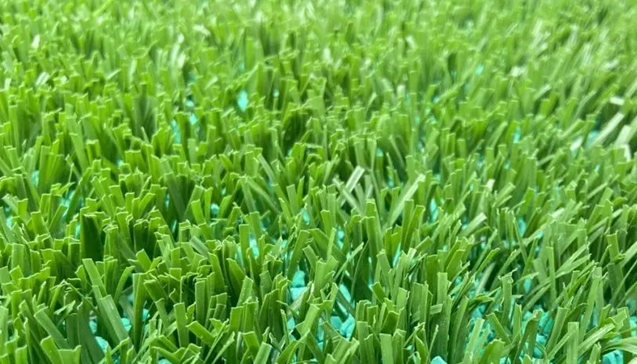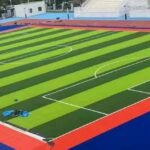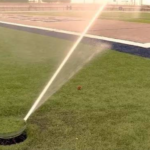
How to install artificial football turf?
① On-the-spot measurement, clean up the ground
②Material approach, lay lawn
③Division of functional areas
④Adhesive fixation
⑤Filled with quartz sand
⑥ Filling particles
⑦Completion acceptance
Artificial grass products are widely used in football fields, hockey fields, tennis courts, basketball courts, volleyball courts, gate courts, running tracks, and other comprehensive sports venues, as well as parks, squares, green spaces, roads, deserts, beaches, hillsides, courtyards, and other fields. Most of the artificial grass on the market has outstanding performance in wind resistance, rain resistance, UV resistance, wear resistance, beautification, greening, etc., and has passed a number of certification tests, reaching the international advanced level.
This article is about two futsal fields with artificial grass that has exceeded its service life, and the height of the grass yarn looks different (caused by improper maintenance), which is a safety hazard.
Due to the high temperature of the football field in summer, sports can only be concentrated at night, which greatly shortens the exercise time. The person in charge of the football field operation proposed the idea of a “water football field”.
In addition to the normal laying of artificial grass on the ground, the construction of the water football field is also equipped with a rotating spray cooling system on the fences on both sides of the football field, which sprays cold water droplets in the hot summer, which can be used for the field before playing. Prepare to spray water to cool down, you can also feel the coolness of the spray while swaying sweat in the process of playing football.
In terms of artificial grass selection, double-sided hydrophobic football artificial grass is used.
In terms of shock absorption, bold attempts and expansions have also been made, abandoning the traditional synthetic material shock absorbing pad, and choosing the method of pouring and paving the whole site with high-elasticity rubber particles mixed with adhesive instead of the synthetic material shock absorbing pad. The flatness can be adjusted twice, the support force is very strong and the elasticity effect is excellent, so athletes will have a feeling of playing on the natural grass, which is very comfortable.
Here are some tips to keep in mind when renovating football fields:
1. Artificial turf renovation means removing the old artificial turf and replacing it with new artificial turf. Then the first step is to remove the artificial turf, which is the key link.
The first thing to pay attention to in the process of removing artificial turf is: do not damage the original artificial turf foundation. The foundation of artificial turf is generally cement, asphalt, or other lime-soil cushions. During the installation process, the artificial turf is bonded to the ground or the joint belt through adhesives. During the removal of the artificial turf, tools are used to remove the artificial turf and the bonding layer. Just remove it, don’t make the potholes damaged by the artificial turf foundation.
2. Before laying new artificial turf, be sure to clean up the site. If conditions permit, it is best to rinse it with water to clean up the floating soil and dust on the site, and then start laying artificial turf.
3. The last point is absolutely necessary. Before laying artificial turf again, you must not start laying directly. You must carefully check and clean the small stones and other foreign objects on the ground to avoid the formation of bulges or damage to the lawn after the lawn is laid. The last point is absolutely necessary. Before laying artificial turf again, you must not start laying directly. You must carefully check and clean the small stones and other foreign objects on the ground to avoid the formation of bulges or damage to the lawn after the lawn is laid.




